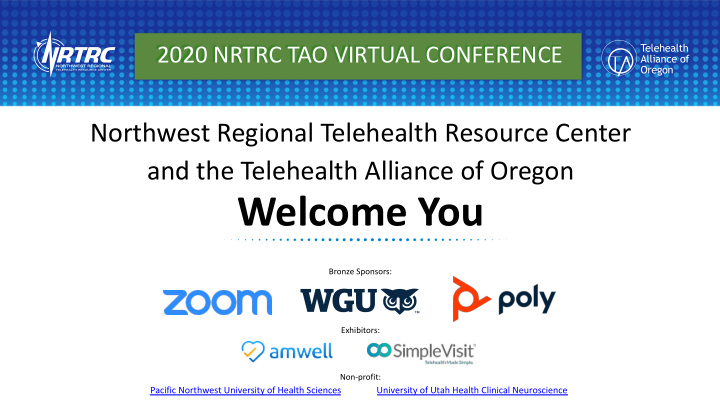



2020 NRTRC TAO VIRTUAL CONFERENCE Northwest Regional Telehealth Resource Center and the Telehealth Alliance of Oregon Welcome You Bronze Sponsors: Exhibitors: Non-profit: Pacific Northwest University of Health Sciences University of Utah Health Clinical Neuroscience
VIRTUAL SESSION INSTRUCTIONS • Audio and video are muted for all participants • Use the Q&A feature to ask questions • Moderator will read questions to the speaker • Presentation slides are posted at https://nrtrc.org/sessions. Recordings will be posted after the conference.
Improving Access to Gender Affirming Care • Moderator: Deb LaMarche • Presenter: – Crystal Beal, MD, QueerDoc
Improving Access to Gender Affirming Care Crystal Beal, MD
About and Disclosures: ● Queer ● Non-binary ● Board Certified Family Medicine Physician ● Physician-Owner QueerDoc ● No other disclosures or funding sources besides my private practice
Agenda/Objectives 1. Define population 2. List obstacles to care faced by gender diverse people 3. Explain how telemedicine reduces said obstacles to care 4. Name limitations in telemedicine based care 5. Demonstrate ability to find referenced resources
What does gender diverse mean?
How many people are gender diverse?
● Fear of disclosure ● Lack of appropriate options Results in Poor Data ● Range: ○ 1 in 250 people -to- ○ 1 in 40,000 people
Barriers to Care
2015 U.S. Transgender Survey Barriers to Care ● Cost ● Fear of being disrespected or mistreated ● Travel distance to gender affirming care
● Insurance coverage ● Surgery denials Cost Barriers ● Hormone denials ● Inability to pay for healthcare
Washington State Cost Barriers ● Poverty rates ● Home ownership rates ● Unemployment rates ● Job discrimination rates
How does telemedicine address cost barriers? ● Decreasing travel costs ○ Gas ○ Transit fares ● Decreasing lost wages from time off work ○ evening, weekend appointments
Fear Barrier ● Fear of mistreatment ● Rates of negative experiences ○ Verbal harassment ○ Refusal to treat ○ Having to teach provider ● Outness to provider
How does telemedicine decrease fear of being disrespected or mistreated? ● Decreasing exposure to potential traumatic interactions ● Containing visit within safety of own home ● Funnels care to providers who are established experts
Distance Barrier ● 63% people receive routine care within 3x 10 mile radius of their home ● Less than 45% receive gender care within 10 miles of their home
How does telemedicine decrease travel distance to gender affirming care barrier? ● Visit anywhere with private internet connection ● No need to drive to experts or centers of excellence ● Access available even in remote and rural areas
Further Benefits of Telemedicine ● Improved access ○ Parity laws ● Cost effective ● Improved Quality ● Provider to provider e-consults
Quality of Care Telemedicine Limitations ● Loss of team-based care ● Physical exam limitations ○ Care coordinator ○ Blood pressure ○ Social worker ○ Auscultation ○ Multi-specialty care ○ Palpation ● Procedural limitations ○ Implant placement
Creative Ways to Decrease Limitations ● Physical exam ● Team-based model ○ Observe ○ Care coordination ○ Visually inspect ○ Incorporate ○ Self-palpation telemedicine into existing COE ● Partner with local clinics for procedures
Physical Exam Example swelling, pain with calf palpation (self exam), I:E ratio ● HEENT AB: appearance, distention, tenderness (self exam), guarding/rebound ● ○ Head: shape, trauma, rash, sinus tenderness (self exam), (self exam), CVA tenderness (assistant exam), scars lesions GU: external appearance, rash, lesions, discharge, swelling, deformity ● ○ Eyes: redness, discharge, visual acuity (self exam/report), MS: appearance (swelling, edema, brusing, lacerations), movement ● swelling, lesions (full ROM, stability), tenderness (point) ○ Ears: redness, swelling, discharge, lesions, deformity Neuro: cranial nerves, gait, speech, orientation, muscle strength/tone ● ○ Nose: redness, swelling, discharge, lesions, deformity, (with assistant exam), sensory function (with assit) impetigo/crusting Pysch: ● ○ OP/throat: cold sores, redness, swelling, exudates, dental appearance, behavior, and attitude ○ hygiene attention and concentration ○ ● Skin: lesions(quality, type, size), wounds (length, type, depth), Higher Integrative Function (Executive Function, Intellectual ○ pain/itching, erythema, cyanosis, blanching, extension, warmth (self Function) exam) Thought Process (Thought Content, Thought Form, Delusion, ○ ● GEN: awake, alert, non-diaphoretic, no psychomotor agitation, Obsession, Abstract Thought) orientation, speech, distress, appearance Speech ○ ● Vitals: temp, RR, pulse (regularity), sometimes BP and pulse ox Affect ○ ● Cardiopulmonary: skin tone, resp distress, speaking in clear sentences, Insight and Judgement ○ signs of cyanosis, capillary refill (self exam), LE edema (self exam), calf Memory Evaluation ○ Orientation ○ Perception (Misperception, Illusion, Hallucination) ○
Limitations in Access to Care ● Need for internet access ● Need for private space ● Communication disabilities (deaf, HOH, visual challenges, language) ● Cultural barriers ● Need to know services are available
My Model: QueerDoc “Queer and gender affirming medicine by a queer and gender diverse doctor” ● Culturally competent ● Culturally humble ● High-quality ● Expert ● Affirming
My Model: QueerDoc- AK, MN, ID ● Direct care telemedicine ● Addressing barriers: model ○ Cost- sliding scale, no ○ Transparent pricing travel costs, advocacy ○ Sliding scale at state level ○ Improved access to ○ Travel- no travel! provider ○ Fear- leveraging social ○ Shorter wait times media
My Model- Alaska Partnered with local brick and mortar LGBTQ clinic Full Spectrum Health They bill insurance ● Patients can use ● Home based hardware ○ Community based hardware ○ In-office video chat hardware ○
Other Telemedicine Gender Affirming Care Models ● QueerMed ● Braeswood Endocrinology ● TRUE U Clinic
Resources ● 2015 US Transgender Survey- http://www.ustranssurvey.org/ ● American Telemedicine Association- americantelemed.org ● “Benefits and drawbacks of telemedicine” (https://www.ncbi.nlm.nih.gov/pubmed/15829049) ● Center for Connected Health Policy- https://www.cchpca.org/ ● QueerDoc- queerdoc.com
Recommend
More recommend